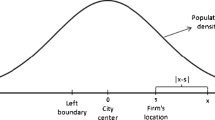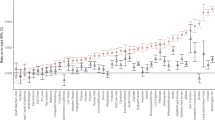Abstract
Reinterpreting Hwang-Mai (AER, 1990) by both simplifying and generalizing their analysis in terms of two key demand parameters representing income and market size, we probe the welfare effects of spatial price discrimination to determine how robust the previous welfare findings in the literature are. Endogenous location matters when a monopolist chooses asymmetric location under different pricing schemes. If he/she remained at the same location, outcomes of fixed and endogenous location models must be analytically the same. Endogenous and different location changes outcomes radically. When non-discriminatory pricing regulations benefit the poor, different transportation burdens mean that the rich become poor, even worse off than the ex-poor, and the society becomes worse off accordingly.
Similar content being viewed by others
References
Anderson, S., P. De Palma and J. F. Thisse (1992) “Social Surplus and Profitability under Different Spatial Pricing Policies”, Southern Economic Journal, Vol. 58, No. 4, pp. 934–949.
Baumol, W. (2006) Regulation Misled by Misread Theory. Perfect Competition and Competition-Imposed Price Discrimination, 2005 Distinguished Lecture AEI-Brookings Joint Center for Regulatory Studies, Washington DC: The AEI Press.
Beckmann, M. J. (1976) “Spatial Price Policies Revisited”, Bell Journal of Economics, Vol. 7, pp. 619–630.
Cheung, F. K. and X. Wang (1995) “Spatial Pricing Discrimination and Location Choice with Non-uniform Demands, ”Regional Science and Urban Economics, Vol. 25, pp. 59–73.
Claycombe, R. J. (1996) “Mill Pricing and Spatial Price Discrimination: Monopoly Performance and Location with Spatial Retail Markets”, Journal of Regional Science, Vol. 36, No. 1, pp. 111–127.
Formby, J. P., S. K. Layson and W. J. Smith (1983) “Price Discrimination, Adjusted Concavity, and Output Changes under Conditions of Constant Elasticity”, Economic Journal, Vol. 93, pp. 892–899.
Greenhut, M. L. (1956) Plant Location in Theory and in Practice, Chapel Hill: University of North Carolina Press.
Greenhut, M. L. (1981) “Spatial Pricing in the USA, West Germany and Japan”, Economica, Vol. 48, pp. 79–86.
—— and H. Ohta (1972) “Output under Alternative Spatial Pricing Technique”, American Economic Review, Vol. 62, pp. 705–713.
—— and —— (1976) “Joan Robinson’s Criterion for Deciding Whether Market Discrimination Reduces Output”, Economic Journal, Vol. 82, pp. 96–94.
Gross, J. and W. L. Holahan (2003) “Credible Collusion in Spatially Separated Markets”, International Economic Review, Vol. 44, pp. 299–312.
Holahan, W. L. (1975) “The Welfare Effects of Spatial Price Discrimination”, American Economic Review, Vol. 65, pp. 498–503.
Hwang, H. and C. C. Mai (1990) “Effects of Spatial Price Discrimination on Output, Welfare, and Location”, American Economic Review, Vol. 80, pp. 567–575.
Kats, A. and J. F. Thisse (1993) “Spatial Oligopolies with Uniform Delivered Pricing”, in H. Ohta and J. F. Thisse (eds), Does Economic Space Matter? Festschrift to Honor Melvin L. Greenhut, London: McMillan Press and New York: St. Martin’s Press.
Liang, W. L., H. Hwang and C. C. Mai (2006) “Spatial Discrimination: Bertrand vs. Cournot with Asymmetric Demands”, Regional Science and Urban Economics, Vol. 36, pp. 790–802.
Mai, C. C. and J. J. Shih (1984) “Output Effect of the Labour-Managed Firm Under Price Discrimination”, Economic Journal, Vol. 94, pp. 931–935.
Ohta, H. (1988) Spatial Price Theory of Imperfect Competition, C. S. Texas: Texas A. & M. University Press.
Ohta, H., Y. S. Lin and M. K. Naito (2005) “Spatial Perfect Competition: A Uniform Delivered Pricing Model”, Pacific Economic Review, Vol. 10, pp. 539–556.
Pigou, A. C. (1929) The Economics of Welfare, 3rd edn. London: Macmillan.
Robinson, J. (1933) The Economics of Imperfect Competition, London: Macmillan.
Schmalensee, R. (1981) “Output and Welfare Implications of Monopolistic Third Degree Price Discrimination”, American Economic Review, Vol. 71, pp. 242–247.
Shih, J. J., C. C. Mai and J. C. Liu (1988) “A General Analysis of the Output Effect Under Third-Degree Price Discrimination”, Economic Journal, Vol. 98, pp. 149–158.
Tabuchi, T. and S-K. Peng (2007) “Spatial Competition in Variety and Number of Stores”, Journal of Economics and Management Strategy, Vol. 16, pp. 227–250.
Thisse, J.-F. (1993) “The Optimal Location of a Firm: Mill Versus Uniform Delivered Pricing”, in H. Ohta and J. F. Thisse (eds), Does Economic Space Matter?, Festschrift to Honor Melvin L. Greenhut, London: McMillan Press and New York: St. Martin’s Press.
Varian, H. R. (1985) “Price Discrimination and Social Welfare”, American Economic Review, Vol. 75, pp. 870–875.
Author information
Authors and Affiliations
Additional information
We are grateful to two anonymous referees for their useful comments and critiques. The third author also wants to express his gratitude for invitation to Tamkang University on their Chair Lecture program, 2006, which has led to the present inquiry among others.
Rights and permissions
About this article
Cite this article
Hwang, H., Mai, CC. & Ohta, H. Who Benefits from Pricing Regulations When Economic Space Matters?. JER 61, 218–233 (2010). https://doi.org/10.1111/j.1468-5876.2009.00484.x
Accepted:
Published:
Issue Date:
DOI: https://doi.org/10.1111/j.1468-5876.2009.00484.x




